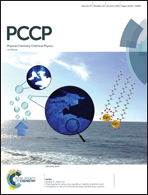Bulk properties of aqueous graphene oxide and reduced graphene oxide with surfactants and polymers: adsorption and stability†
Abstract
A diverse range of molecular surfactants and polymers have been incorporated into aqueous graphene oxide (GO) and reduced graphene oxide (rGO) dispersions in order to understand the complex relationship between surface chemistry, surface forces and interfacial thermodynamics of these materials with typical amphiphiles. Surfactant additives were systematically varied in terms of their charge and hydrophobicity to reveal important structure–function relationships affecting adsorption and interaction with GO and rGO surfaces. Small-angle (and ultra small-angle) neutron scattering was employed to examine and monitor the interactions and self-assembly in each system. Charge was found to be the overriding factor driving adsorption, as cationic surfactants very readily adsorbed to both GO and rGO, whereas anionic surfactants gave little to no evidence of adsorption despite possessing hydrophobic tail-groups. Molecules of neutral charge such as nonionic and zwitterionic surfactants as well as neutral polymers also showed strong affinities for GO and rGO, indicating that dispersion and dipole (induction polarisation) interactions also play a significant role in adsorption with these materials. Modelling the neutron data revealed in many cases a q−2 slope in the low q and ultra low q regions, indicating that scattering was occurring from large, flat surfaces (lamellae or bilayers), suggesting an effective flattening of the sheets in dispersion. The results presented thus help to form a roadmap for the behaviour of GO and rGO with surfactants and polymers, relevant to adsorption, stabilisation, formulation and coating in aqueous environments as adsorbent and functional materials.



 Please wait while we load your content...
Please wait while we load your content...
